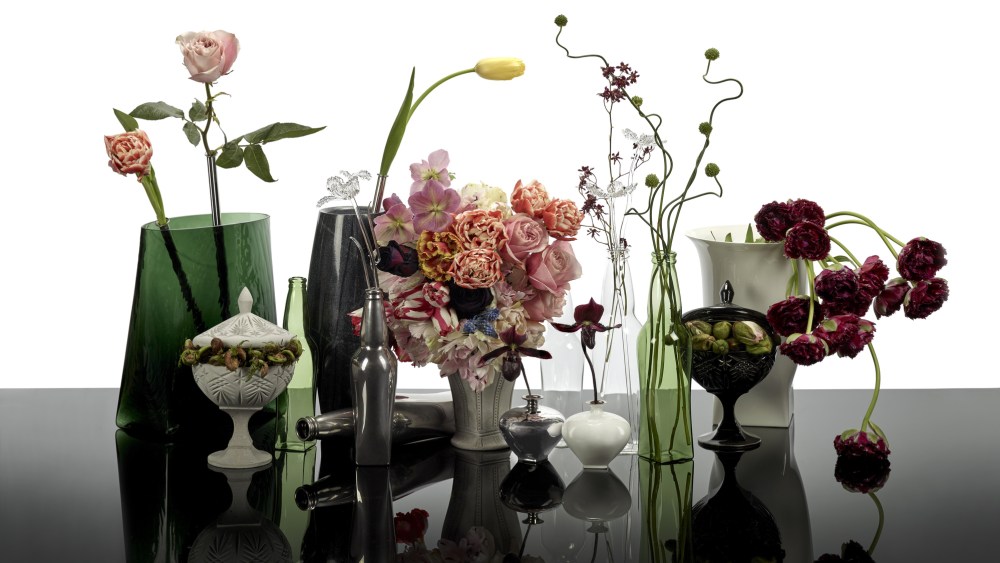Kris Van Assche is out to make flower arranging more modern, more poetic — and a little disruptive.
His new collection for Belgian homewares specialist Serax includes glass poppies and orchids that will never wilt; long silver-plated glass tubes to water and exalt a single stem, and vases in such unusual materials as concrete, marble and silver-plated porcelain.
Just launched on serax.com, The Josephine Collection proves that the unexpected elements that often sparked Van Assche’s menswear designs for Berluti and Dior — tribal tattoo motifs one season, punk badges the next — can also apply to vessels.
To be sure, the Belgian designer brought almost a lifetime of flower-arranging appreciation to the project, named after his late grandmother and sometimes directly inspired by her vases and candy dishes.
“She had not so much money, but she definitely had a high taste level and she was definitely a fan of keeping up appearances,” Van Assche said. “She would never leave the house without a hat, and she would always set a nice table, even for a quick lunch. For her, both were a form of politeness.”
Kris Van Assche
Courtesy of Serax
In an interview, the designer cited a strong appreciation for “old-world beauty” — and for the provocative flower photos of American artist Robert Mapplethorpe, who often depicted stems jutting horizontally from a vessel and sagging sensually.
But the designer also flexed his fashion training at Antwerp’s Royal Academy of Art, which demanded fashion students dissect historical garments and then find ways to interpret them in original and contemporary ways.
Hence Van Assche insisted on a rectangular base for all his vessels, which not only adds stability but telegraphs a more modern and minimalist sensibility. He mentioned that his menswear designs typically start with the shoulder line and the shoes, which “have a big influence on the allure of the silhouette.”
The long glass tubes, which protrude diagonally from an empty vase, can harbor the last-surviving stem from a bouquet — or be employed in busier arrangements.
Meanwhile, glass flowers also add a disquieting element — an artificial invader among live specimens.

A square-bottom vase with a glass orchid.
Courtesy of Serax
The collection ranges from humble beer-bottle shapes — the makeshift vase of students, and Van Assche — to grander botanical and rotund vessels.
Prices start at 49 euros for a small bud vase and run up to 560 euros for a tall black marble cylinder, though most vases fall in the neighborhood of 200 euros. Glass poppies and orchids go from 42 euros to 69 euros, while candy dishes go from 95 euros to 260 euros.
Van Assche was familiar with Serax as a client of its tableware by Ann Demeulemeester, one of dozens of designers who create china, glasses, lighting, furniture and home accessories for the firm, founded in Belgium in 1986 by brothers Serge and Axel Van Den Bossche.
Happy to be taking a break from fashion, but missing interactions with craftspeople, he reached out to Serax directly, secured a meeting with the chief executive officer and soon embarked on a yearlong process to bring The Josephine Collection to life.
His initial idea was to create artificial flowers in the same material as the vase, whether it was glass, concrete or marble. (In the end, only glass ones were technically possible.)
“I always feel like vases are either hidden by a beautiful bouquet of flowers when they’re full or when they’re empty, you put them in a closet. You never look at the vase as an object by itself,” he said in the interview. “I quite liked the challenge of making a vase that would be somehow self-sufficient, that would work with flowers or without.
“I also really like that idea of multiple functions for one vase. So all of these vases are delivered with one tube inside, so you can always save the one flower that survived after a week.”
Van Assche said he owns about a dozen vases, but “for some weird reason, I don’t really have the type of vases that I like and that I need.”

Silver-plated glass tubes add a frisson of sci-fi to a sparse bouquet.
Followers of Van Assche on Instagram are familiar with his forearm tattoos — orchids on his left arm, tulips on the right — and his mirror selfies cradling bunches of flowers in the foyer of his apartment building. He said he often buys them at the market as a reward for the chore of food shopping, or at his favorite Paris florist, Louis-Géraud Castor, who shares his penchant for “creating tension in the bouquet. There’s always a contrast or something off balance.”
For his Serax photo shoot, Van Assche collaborated with celebrated Antwerp-based floral artist Mark Colle, who famously created walls of blooms for Raf Simons’ Dior debut in 2012.
The addition of glass tubes certainly adds another dimension to both sparse and dense arrangements. “It almost looks like a ‘RoboCop’ kind of bouquet,” Van Assche remarked, referring to Paul Verhoeven’s 1987 American science fiction film.
Meanwhile, his revival of the candy dish is another tribute to his grandmother, who stocked hers with chocolate and ultimately willed them to her grandson.
“It’s probably the most old-fashioned item I have ever designed, and it was a way of emphasizing this idea of old-world beauty,” he said. “I liked how it’s almost impossible to make that object modern, to give that an update. And yet I feel like by making them in concrete, or silver-plated china, we actually got away with it.”

Candy dishes by Kris Van Assche for Serax.
Courtesy of Serax

